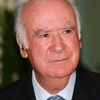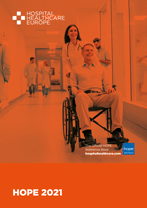HOPE Governors discuss their national COVID vaccination programmes and delivery, and the consequences of the pandemic on physical and mental healthcare provision to non-COVID patients
Data were obtained from the OECD, Eurostat and WHO. When data were not available for one of the specific years, the closer year was used (denoted by *)
AUSTRIA

HOPE Governor
COVID-19 vaccination: how did it go, and what was the involvement of hospital and healthcare services, adherence of healthcare staff?
Austria determined a country-wide prioritisation. The prioritisation focuses on medical criteria for people with a high risk of severe and fatal outcomes when infected with SARS-CoV-2, or with high exposition while being part of essential services (e.g., health care staff, long-term care staff). The organisation and planning of the vaccinations was done regionally, on the level of the federal states. In the beginning of the vaccination process the in the EU known lack of sufficient vaccination doses led to fewer possible immunisations. First batches of vaccines were assigned to residents of retirement and nursing homes, the respective personnel and to health care workers and were administered on-site. These groups were followed by the general population of and over the age of 80. Gradually the pace picked up, with more doses available vaccines were further administered to the most vulnerable groups in age and underlying disease.
By 31 May 2021, 41% of the Austrian population had received at least one dose of the COVID-19 vaccine. A dashboard is available with online tracking of the progress and actual delivery of vaccine doses: https://info.gesundheitsministerium.at/. Austria is set on having immunised all people who want to receive the vaccination by the end of July 2021.
The health care workers were immunised directly in the hospitals and the adherence of physicians was very high, whereas nurses and other health care professions had a vaccination rate of approximately 50%–60%. Some federal states have vaccination centres for the general public, others also relied on their general practitioners right from the start of the vaccination process. In addition, mobile vaccination sites (‘Impfboxen’) were installed to offer low-threshold access to the COVID-19 vaccination.
What were the consequences on the care delivered to non-COVID patients both on somatic and mental health (figures available, measures taken, etc)?
During the three COVID-19 waves, some or all elective surgeries in the federal states had to be reduced to ensure enough capacities for COVID-19 patients in intensive care units. Until now, these treatments are being made up for. The long-term consequences cannot substantially be determined at this point. Mental health is a big focus, as depression, anxiety disorders and other mental health problems have been aggravated during the pandemic. In the Ministry of Health, an advisory group of experts works on necessary measures to be taken, also addressing the mental health state of children and juveniles and the subsequent issues arising.
We commissioned a study on the impact of the pandemic on inpatient care in Austria in 2020 (available at https://jasmin.goeg.at/1633/). Unfortunately, the study is only available in German. Result is: In the areas analysed there was, with the exception of strokes, a reduction in inpatient stays in the months of March to May 2020 and in November and December 2020 compared with previous years, although the reduction during the second lockdown was not as significant. Due to sufficient personal protective equipment, more testing possibilities and an increased knowledge about COVID-19 gained over the course of the first phase of the pandemic, the reduction was comparatively moderate, taking into account the relatively high number of hospitalised COVID-19 patients.
DENMARK

Mrs Eva Weinreich-Jensen
HOPE Governor
COVID-19 vaccination: how did it go, what was the involvement of hospital and healthcare services, adherence of healthcare staff?
In general, there has been a high willingness in Denmark to receive the vaccine. By mid-September 2021, all citizens over the age of 12 had been offered vaccination against COVID-19. As of today, more than 4.4 million citizens have been vaccinated with at least one dose; this is equivalent to more than 75% of the total population and over 86% of the population above 12 years.
The Danish COVID-19 Vaccination programme is centrally governed. The Danish Health Authority has been responsible for planning the programme and determines who should be vaccinated and in which order. At first, the limited supply of vaccine was prioritised to citizens in nursing homes, health staff and the elderly and vulnerable population. Afterwards the roll-out has generally been based on age.
The authorities in Denmark’s five regions have been administering and carrying out the vaccinations. The regions are administrative entities at a level above the municipalities and below the central government and in charge of health care and public hospitals.
Most citizens were invited for vaccination through a secure public e-mail system (eBoks) that allows them to book a time for vaccination digitally. Most vaccinations take place in regional vaccination centres established for this specific purpose. Some take place in more local settings with outgoing units from the vaccination centres carrying out the vaccinations: for instance, for residents and staff at nursing homes or immobile citizens. Vaccination of hospital staff and hospitalised patients is administered at the hospitals. Vaccination is voluntary and free of charge.
What were the consequences on the care delivered to non-COVID patients both on somatic and mental health (figures available, measures taken, etc)?
It has been very important for the Danish regions to find out the consequences of coronavirus for non-COVID patients. Therefore, the regions created a panel of experts, which has been investigating the consequences on the health and well-being in Denmark and make recommendations. Although Denmark was in an extraordinary situation as a result of the coronavirus, the situation has shown that the Danish Healthcare System overall has been able to adapt to a crisis situation. Examination and treatment of patients with acute and life-threatening diseases has been prioritised and maintained throughout the entire pandemic. In an international perspective, cancer treatment in Denmark has, for instance, performed well during the crisis. However there has been a periodically decline in the activity in the non-acute and non-life-threatening areas, so that health care resources could be prioritized to treat corona patients.
Studies indicate that some citizens have experienced an impact on their mental health during the pandemic due to, for example, increased loneliness and isolation. It is likely that mental health will normalise for many in the wake of the crisis, but for some groups, we can expect more long-term negative effects. It is not yet possible to assess whether the mental health of the population in general will return to the same level as before coronavirus, once society is reopened, or whether the people who have been affected negatively will have poorer mental health in the long run. This requires follow-up studies and an increased focus moving ahead.
ESTONIA

Dr Urmas Sule
HOPE President
COVID-19 vaccination: how did it go, what was the involvement of hospital and healthcare services, adherence of healthcare staff?
The vaccination target in Estonia was for 70% of adults to be vaccinated by the start of autumn; unfortunately, this does not seem to have been achieved in time. From the start, Estonian data were very similar to those in Sweden, the main difference being Sweden has a greater number of elderly people already vaccinated. Today our numbers are lower. The vaccination programme started just after Christmas 2020, with healthcare workers and older people in care homes. This was a wise decision as hospitalisation cases dropped among the elderly (from over 20% to 1% among residents of care homes). The decrease of morbidity among healthcare professionals has also been remarkable, and this significantly increased the capacity of the health care system to cope with the crises. Later the State Immunoprophylaxis Expert Committee gave new instructions on selection of risk groups to vaccinate next, step by step. As there was very high demand at the start, this was done according to the amount of vaccine available in Estonia at that moment. Vaccination centres opened in May 2021 and vaccination was available to all adults in Estonia, including non-nationals. In addition to the vaccination centres, hospitals and family physicians continued to carry out vaccinations. As of September 2021, 66% of the adult population, including 72% of elderly people, had been vaccinated. Our biggest challenge concerning vaccination today is primarily a socio-psychological one.
What were the consequences on the care delivered to non-COVID patients both on somatic and mental health (figures available, measures taken, etc)?
There was a considerable burden on hospitals during the second wave, because infection rates increased rapidly and many people needed specialised care. In March and April during the peak, there were over 700 people (over 54 per 100 000 inhabitants) hospitalised with COVID. Our health professionals have given their best to solve the crisis. We were also able to widely involve medical and nursing students with cooperation of University of Tartu and two Health Care Colleges.
To contain the virus, strict restrictions were also established by the Government of Estonia from 11 March 2021. The synergies between these activities were finally effective.
Long-COVID, mental health and waiting lists are also areas of concern in Estonia. Mental health problems – depression, anxiety, burnout, etc – had already emerged during the first wave of the virus crisis, and been exacerbated by the second wave. Continuous feeling of danger and stress among health professionals and other professions who have close contact with other people, has had and will have long-term effect on mental health.
During this difficult time, the Estonian Hospitals’ Association was also negotiating with health care workers’ unions regarding a collective agreement. In the last days of April 2021, after long discussions through a national conciliator, the Hospitals Association, the Medical Association, the Healthcare Workers Professional Association and the Professional Association of Clinical Psychologists reached an agreement, and a new collective deal was signed. This agreement contained for the first time also clauses about workers’ mental health and care. Unfortunately, the Nurses Union separated and did not sign this agreement, but the interests of nursing staff are considered in the same way.
The annual increase in morbidity started three months earlier than last year. At the beginning of September 2021, the Estonian government decided to implement a new COVID-19 risk level assessment model. The introduction of the new matrix will help to assess the situation of COVID-19 in the country more realistically, as more than half of the population have been vaccinated for COVID-19 at least once, which was not considered in the previous risk matrix.
GERMANY

Dr Gerald Gass
HOPE Governor
COVID-19 vaccination: how did it go, what was the involvement of hospital and healthcare services, adherence of healthcare staff?
From end of December 2020, Germany followed a stepwise and group-wise vaccination approach to prioritise COVID-19 vaccination (Vaccination approach RKI). The five groups were defined by the Robert-Koch-Institut (RKI) in the form of a recommendation. As in Germany it is up to the Federal states (Bundesländer) to translate these recommendations into binding legal acts, there were minor differences in the definition of the priority groups and in the timing of the vaccinations between the Bundesländer. In the first phase (28 December 2020 to 7 April 2021), the vaccinations were carried out exclusively in vaccination centres set up for this purpose. As of 7 April 2021, vaccinations were also administered by general practitioners and by in-house company doctors. Hospital staff were immunised as the first priority group from January 2021. For this purpose, the German hospitals received the corresponding doses for the vaccination of their staff. Beyond that, hospitals were not involved in the vaccination of the population. As of mid-September (15 September 2021), 63% of the total population is fully vaccinated and 67% of the total population is at least partially vaccinated (primary vaccination). As in many other European countries, Germany is currently discussing different motivational/incentive systems and mandatory options.
What were the consequences on the care delivered to non-COVID patients both on somatic and mental health (figures available, measures taken, etc)?
As in our neighbouring countries, the unprecedented COVID-19 crisis has created major challenges for regular inpatient and outpatient care. In Germany, the Federal States (Bundesländer) are responsible for the on-site organisation and planning of hospital care. In 2020, from mid-March onwards, the Bundesländer enacted regulations to create a legal framework for the downscaling of elective care procedures to be prepared for a worst-case scenario. The German hospitals largely followed the national request and the regional regulations. All decisions taken by the hospitals were guided by the principle that the evaluation of elective procedures is subject to the primacy of medicine. Decisions were taken most carefully after an in-house evaluation of each individual medical situation. Thanks to the treatment capacities in the German hospital sector, the teams were fortunately able to catch up on most of the procedures in the subsequent summer months. We can be grateful that we are currently not struggling with an unmanageable backlog situation. However, consequences on the care delivered to non-COVID patients, both in terms of somatic and mental health, must be further evaluated.
LUXEMBOURG

Mr Marc Hastert
HOPE Governor
COVID-19 vaccination: how did it go, what was the involvement of hospital and healthcare services, adherence of healthcare staff?
On 12 September 2021, Luxembourg had 1067 active infections and a total of 77,100 infections since February 2020. In total, 834 people have died since March 2020. Yet, there are only 27 people in the hospital due to COVID-19, including 9 people in ICU. Seventy-two per cent of the eligible population (12+) are fully vaccinated and 1000 people are vaccinated every day with EMA-approved vaccines. The AstraZeneca vaccine is only used in the older population and for younger patients on a voluntary basis. In hospitals, 75% of workers are vaccinated, professionals always have priority, but it is not mandatory. This will not change in the future. The current practice in hospitals is for workers to perform a test before starting the day; this is only a recommendation but, if they refuse, they will be assigned to a service without risk to patients. Visitors also require testing, and a COVID-19 passport is currently being implemented.
Meanwhile, a general COVID check obligation will apply in hospitals in future: according to this, every person entering a hospital must in principle show proof of vaccination, a negative test result or recovery. Only emergency patients are exempt.
What were the consequences on the care delivered to non-COVID patients both on somatic and mental health (figures available, measures taken, etc)?
Concerning non-COVID patients, there have been few issues thus far, except in mental health, but this is a pre-existing problem as there are not enough psychiatric centres. COVID-19 counselling centres have been closed and the general practitioners are the points of contact. There is also a two-way stream being implemented in emergency services for COVID-19 patients and for non-COVID-19 patients.
PORTUGAL

Prof Carlos Pereira Alves
HOPE Governor
COVID-19 vaccination: how did it go, what was the involvement of hospital and healthcare services, adherence of healthcare staff?
Vaccination in Portugal is centralised, managed by the Vaccination Task Force, designated by the Government. Vaccination is administrated by the Portuguese National Health Service (Serviço Nacional de Saúde – SNS) network, following the Vaccination Plan against COVID-19, which is dynamic and adjusted according to the evolution of scientific knowledge, the epidemiological situation at each moment and the availability of vaccines.
The plan foresees three phases. At the moment, Portugal is in the third phase, vaccinating mostly young people and a second dose to the rest of eligible population. An average daily rate in the fourth week of September 2021 was 34,515 vaccinated people (with the record of 148,000 on 12 July 2021).
As of 26 September 2021, 88% of the population had already received at least the first dose of the vaccine and 85% of the population has already been fully vaccinated, meaning that 98% of all of those eligible for vaccines – anyone over 12 – have been fully vaccinated.
What were the consequences on the care delivered to non-COVID patients both on somatic and mental health (figures available, measures taken, etc)?
In order to give priority to COVID patients, the activities in the Portuguese National Health Service were suspended for some time in 2020, so public hospitals carried out 18% fewer operations than the year before. At the end of 2020, hospitals started recovery plans that had to be interrupted at the beginning of 2021 due to the second wave of COVID-19 that overcrowded the institutions, preventing them, even for safety reasons, from allocating resources to non-COVID patients. Currently most institutions have already resumed recovery plans for suspended non-COVID activities, so they either work normally or with extended schedules to restore the waiting lists, but it will be a slow process.
SPAIN

Mrs Sara Pupato Ferrari
HOPE Governor
COVID-19 vaccination: how did it go, what was the involvement of hospital and healthcare services, adherence of healthcare staff?
In September 2021, there were more than 37 million people vaccinated (78% of the population, being 75% fully vaccinated). Vaccination is seen as one of the main achievements of health care services, either at central level, the Ministry of Health, or at regional levels. Organisation is perceived as effective by the population. All types of facilities are being used for the Vaccination Programme. Neither health care professionals nor the general population encountered problems being vaccinated. Vaccine hesitancy is not significant. A COVID passport is seen as one of the potential solutions for the tourism sector crisis.
What were the consequences on the care delivered to non-COVID patients both on somatic and mental health (figures available, measures taken, etc)?
As in other EU countries, the delivery of non-COVID-related health care services has been directly pressured and often compromised at all levels because of the pandemic. In general, there has been a postponement of elective medical procedures while there has been an increase in digital healthcare technologies use for regular consultations.
Postponement of elective medical procedures was mainly due to the lack of workforce, operating rooms and availability of beds. Some professionals were reallocated. Waiting lists have increased approximately from 7% to 19% depending on the region.
Studies done during the first wave showed: a decrease in cancer routine procedures; 97% of consultations were by phone; and 20% fewer biopsies and consultations. It is estimated that in this period 1 out of 5 patients has had a delayed diagnosis. There has also been a decrease in the number of urgent consultations for stroke, cardiovascular and neurological conditions in emergency rooms, by 15%–32% depending on the region. For primary care, studies show 75% fewer face-to-face consultations and an important increase in telemedicine. From the patients’ point of view, procedures planned before the pandemic were delayed or cancelled, and problems with medications were also reported. Temporary closure of primary care centres occurred and waiting lists for family care doctors have increased from 1–3 days to 3–6 days in 2020. A mental health study has shown an increase of eating disorders in children and adolescents during the pandemic. In public health, as the workforce was prioritised to the pandemic, screening programmes were affected as well as usual networks for other diseases.
Although the pandemic is still affecting healthcare services directly, great efforts are being made during 2021 to ensure access, rapid and appropriate services to non-COVID patients to recover the pre-pandemic situation. Waves of COVID infection and lack of workforce appear to be the main obstacles to achieving this goal.
SWEDEN

Mr Erik Svanfeldt
HOPE Governor
COVID-19 vaccination: how did it go, what was the involvement of hospital and healthcare services, adherence of healthcare staff?
In Sweden, vaccination is voluntary and the willingness to be vaccinated is generally high. As of 22 September 2021, 83% of all residents aged 16 and over had received at least one dose and 75% had received two doses. The rate of vaccination was higher among elderly people, as this age-group had been given priority, and the lowest among 16- and 17-year-olds who could start receiving the vaccine at the end of the summer of 2021. From October 2021, it will be possible also for young people aged 12–15 to get vaccinated in Sweden.
Statistics also showed that the vaccination rate was much higher among healthcare staff compared with other people of working age. But among social care staff, the figures were about the same as for the population in general.
A big challenge is the fact that the vaccination rate is lower among residents born outside Sweden, and among persons with low education and low incomes. This is something that requires targeted actions, and great efforts are being made to reach these groups as well.
In Sweden, vaccination is a regional responsibility. COVID-19 vaccinations take place in many different settings: often in temporary premises or drive-in centres, but sometimes also at primary care centres and hospitals. To reach out wider, the regions have also started mobile vaccination services offering vaccination outside schools, universities, churches, sports arenas etc.
Sweden has mainly used the Pfizer/BioNTech vaccine, but also the Moderna vaccine.
What were the consequences on the care delivered to non-COVID patients both on somatic and mental health (figures available, measures taken, etc)?
The COVID-19 pandemic has had many different effects on the Swedish healthcare services. Before the pandemic, Sweden had a low number of ICU beds, but then hospitals in a short time managed to transform wards into intensive care units, and transfer healthcare professionals from one part of the system to another. There was also a significant increase of digital services, a change that is expected to continue.
At the same time, there was less pressure on other parts of hospital services (cardio, cancer) and less pressure on primary care. Planned treatment was postponed and waiting times were extended. Between March 2020 and January 2021, the total number of surgeries decreased by 22% compared with the same period in 2019–2020. The number of planned surgeries decreased by 30%. The largest decreases in the total number of surgeries/interventions occurred in orthopaedics, general surgery and ophthalmology. The number of people waiting more than 90 days for a surgery/intervention has increased significantly since March 2020.
UNITED KINGDOM

HOPE Governor
COVID-19 vaccination: how did it go, what was the involvement of hospital and healthcare services, adherence of healthcare staff?
By September 2021, the UK had had over 7 million cases1 and 156,000 deaths where COVID-19 was recorded on the death certificate.2 The more transmissible delta variant led to a large uptick in cases from July 2021 onwards, with cases peaking at over 60,000 on one day; however, the vaccination roll out has helped break the link between cases and deaths. Public Health England estimates that over 143,000 hospitalisations for those over 65 have been prevented as a result of the vaccination programme, and estimated deaths prevented are now over 105,000.3
Initially the vaccination programme was managed by hospitals but has since been well established at local sites in primary care and mass vaccination sites. Healthcare staff, the elderly and vulnerable were initially prioritised but now over 80% of people aged 16 and over have had both vaccinations (over 43 million people) and nearly 89% have had one dose.4 The latest figures we saw suggested 90 % of frontline staff have been fully vaccinated and 80% of all staff had received both doses. Some NHS organisations have started to redeploy staff who have not been vaccinated away from the frontline. Research shows high vaccination trust compared to other countries, with a study in June noting 87% of respondents ‘had faith in the jab’.5 Reasons given by people to not get vaccinated are mainly fear of side effects, and long impacts that people did not feel could yet be known. Research by the Office of National Statistics (ONS) also showed a secondary factor of people feeling they did not think COVID-19 vaccines were necessary as they did not think it was a significant risk to them, often because they were younger and did not think they would develop serious symptoms, or they would not need to the jab because they felt they were taking adequate steps to avoid catching COVID-19.6
The UK initially took a policy of a three-month gap between doses which led to more people being vaccinated, but with the delta variant spike during the summer, people were encouraged to bring their vaccination forward to the eight-week mark.7
What were the consequences on the care delivered to non-COVID patients both on somatic and mental health (figures available, measures taken, etc)?
The main challenge is the backlog of care. Nearly 5.5 million people were waiting for treatment as of June 2021, the highest number since records began,8 in February 2020 before the pandemic, this stood at under 4.5 million. It is estimated that over 7 million people did not come forward for treatment during the pandemic that would have come forward usually and there is now a question of how many of those people will present for treatment, increasing the demand on the service as it recovers. More than 300,000 people in June 2021 were waiting more than 52 weeks; this is compared with just over 1600 in February 2020.
There has also been a rise in some mental health issues, with data showing a considerable rise in young people treated for eating disorders as well as those waiting for treatment, the latter of which increased 173% from the end of 2019/20 to the end of 2020/21.9
Research predicts England will have up to 10 million people who need support with mental health issues because of the pandemic.10 Long-COVID is also a topic of interest in the UK, both in the general public and across NHS staff, with figures in April suggesting that over 120,000 health care workers may have been affected.11
References
- GOV.UK (2021) Cases in the UK. https://coronavirus.data.gov.uk/details/cases
- GOV.UK (2021) Deaths in the UK. https://coronavirus.data.gov.uk/details/deaths
- Public Health England (2021) COVID-19 Vaccine Surveillance Report. www.gov.uk/government/news/COVID-19-vaccine-surveillance-report-published
- GOV.UK (2021) Vaccinations. https://coronavirus.data.gov.uk/details/vaccinations
- BBC News (2021) UK ‘most trusting’ country on COVID vaccines. www.bbc.co.uk/news/health-57348114
- ONS (2021) COVID-19 vaccine refusal, UK. www.ons.gov.uk/peoplepopulationandcommunity/healthandsocialcare/healthandwellbeing/bulletins/COVID19vaccinerefusaluk/februarytomarch2021
- The Guardian (2021) Pfizer vaccine second dose has ‘sweet spot’. www.theguardian.com/world/2021/jul/23/pfizer-vaccine-second-dose-has-sweet-spot-after-eight-weeks-uk-scientists-say
- NHS England (2021) Consultant-led RTT data 2021-22: www.england.nhs.uk/statistics/statistical-work-areas/rtt-waiting-times/rtt-data-2021-22/
- NHS England (2021) CYP eating disorder waiting times. www.england.nhs.uk/statistics/statistical-work-areas/cyped-waiting-times/
- Centre for Mental Health (2021) Up to 10 million people in England may need support. www.centreformentalhealth.org.uk/news/10-million-people-england-may-need-support-their-mental-health-result-pandemic-says-centre-mental-health
- APPG on Coronavirus (2021) Transcript: Long COVID and Employment. https://appgcoronavirus.marchforchange.uk/publications_appg





